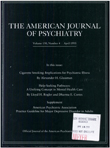A review of 32 cases of tardive dystonia
Abstract
OBJECTIVE: Tardive dystonia, historically combined with tardive dyskinesia, is now viewed as probably having a different pathophysiology, course, outcome, and treatment response than tardive dyskinesia. In addition, patients with tardive dystonia are reported to be younger, and most are men. This study evaluates characteristics of 32 patients with tardive dystonia and compares results to other reports. METHOD: Twenty-four patients had been referred for research purposes and were videotaped, while eight had been followed clinically. Two of the authors reviewed all available videotapes and clinical reports to assess the course of symptoms over time. For global ratings and ratings of affected body parts, two scales were used: the Abnormal Involuntary Movement Scale (AIMS) for tardive dyskinesia and a similar scale for tardive dystonia. The method of case finding does not provide incidence or prevalence data for tardive dystonia. RESULTS: Fifty-nine percent of the patients experienced onset of tardive dystonia symptoms within 6 years of antipsychotic drug exposure; women had a shorter exposure time. No patient had complete remission of tardive dystonia symptoms, and 22 were moderately or severely impaired when their movements were most prominent. CONCLUSIONS: While epidemiological studies of tardive dystonia have yet to be performed, these results support the observations of others that most patients with tardive dystonia are men, have a short history of exposure to antipsychotic drugs, and may initially present with blepharospasm. Tardive dystonia rarely remits completely, can cause notable disability, and may partially respond to anticholinergic agents.
Access content
To read the fulltext, please use one of the options below to sign in or purchase access.- Personal login
- Institutional Login
- Sign in via OpenAthens
- Register for access
-
Please login/register if you wish to pair your device and check access availability.
Not a subscriber?
PsychiatryOnline subscription options offer access to the DSM-5 library, books, journals, CME, and patient resources. This all-in-one virtual library provides psychiatrists and mental health professionals with key resources for diagnosis, treatment, research, and professional development.
Need more help? PsychiatryOnline Customer Service may be reached by emailing [email protected] or by calling 800-368-5777 (in the U.S.) or 703-907-7322 (outside the U.S.).



